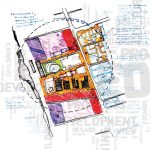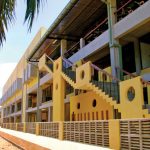-
Growing a city, The Asian Way
March 2008
Architect Harsha Fernando has his own architectural practice. In this interview with The Architect they discuss the changing face of an Asian City and the importance of embracing urban design and planning as part of a sustainable future.
Photography by Varuna Liyanage
What is your definition of a city?
Archt. D B Navaratne (DBN) – A city is something which is developed through time, and is defined in many ways. One very basic and practical definition could be ‘a location where many diverse activities take place, in a high-density situation.’ So in essence, the nature of a city is where population density is very high, coupled with a multiplicity of activities, all in a fast moving space.
From a physical standpoint there is a transportation network, including both vertical and horizontal forms, in addition to buildings and open spaces. A city however is a much more complex place and one that has been evolving through history. Complex, in the sense that, some cities are the driving force of economies. Sometimes a city is a place of employment, sometimes a place of opportunity and sometimes, cities are countries, as in the case of Singapore and Hong Kong.
Cities also have a cultural and historic relevance and what makes a city interesting to live in are these multiple facets, in addition to its fast pace of change.
From a point of view of architecture and urban design, it is a place where you will have different spaces fulfilling different requirements — collectively referred to as a ‘city.’
Cities are built on many geographical situations such as marshes, solid rock or even on mountains. Individuals react and respond to natural surroundings and elements and thus the shape of a city changes. This is especially so when a city is in the process of being created.
When it comes to city design there are a number of approaches and some have stood the test of time while some have not.
Archt. Harsha Fernando (HF) -In my thinking ‘a city’ is a place where a society shares amenities. This is in contrast to remote areas where you may have your own individual water supply etc., but city living changes this practice. It is in fact a lifestyle that has evolved from history amidst changing contexts, but the basic, core concept remains the same.
Culture, economy and context gives a city its identity. A good example of this is rural China. Cities evolve and it is impossible to create a city overnight. Things will be added or removed and some things will shrink or grow as well. The density of a city’s residents contributes in a large manner to its evolvement.
It is now the duty for urban designers and planners to harness and direct this growth.
What makes a city Asian?
HF – You cannot make a city simply Asian. It can be a city by itself such as Kandy and Colombo. But what we can do is derive some common characteristics from an Asian city. If you were to go to New York or Chicago, you would notice little difference. This is also the case in Japan where from Osaka to Tokyo to Yokohama, you would find very little in terms of differences. You never feel that you are out of Japan.
From an Asian perspective we have a lot of social tiers that are reflected in our cities. You get social layering in other cities as well, but this plays a greater part in Asian cities. The other aspect is ‘chaos.’ Chaos is something we all have to live with, but the hallmark of a great city is in how it manages its chaos. Some may take a negative view of this notion but for me chaos should be viewed positively mainly because it is part and parcel of our own culture. We like chaos sometimes; otherwise life gets a tad too dull and boring at times.
DBN – The Asian city dweller is used to chaos as it is something they are familiar with. This is in comparison with European cities where boundaries are quite evident. Asian cities are expanding one into another, but perhaps because of our culture and our philosophy we are familiar and comfortable with all of this.
Most Asian cities have evolved instead of being planned so with many complexities, there is also a historical element running underneath. Some individuals display nostalgia towards these spaces, buildings, trees and waterways etc.
In an effort to protect these, they continue to live within them. A good example is when certain trees or streets become part and parcel of the identity of a city. Another common characteristic is that most Asian cities, with a few exceptions, are not really developed.
So, in this context, Asian cities have a low rise, high-density character. European cities on the other hand have high density, high rise characters. One reason for this apparent high-density situation is the employment generation that a city offers.
In addition to this is the service element. For cheap labour, you must also have cheap accommodation and this is a crucial problem in most Asian cities. Coupled with this is the constant influx of those from rural areas into the cities.
Many Asian cities that find themselves in this situation are trying to effect change, but are often faced with a dilemma – which city model do they follow? Do they follow a European model or do they apply a model that integrates Asian character and values?
DBN – Most early models talked about the concept of ‘zoning’ where you would zone off areas for living, working, playing etc. Hospitals and cemeteries, for example, would be zoned out into different areas. But rapid urbanisation has offered a new perspective on this concept.
Today we see mixed uses in a single zone. You may have an office block that contains a nightclub and residences. Single urban elements are used for different activities at different times of the day. For example, some city streets are transformed into night markets. Visit the street the next morning, and you will be greeted by smart office blocks and busy city dwellers.
A space has multiple functions and it is these forms of activity that sets apart the Asian way of living. In contrast, night markets in Europe are often housed in purpose-built spaces and offer little spatial flexibility for multiple use.
The former zoning system saw many zones being deserted after a certain time. It would be busy for the first 12 hours of the day and then the next 12 hours would be dead. Planners are beginning to understand this situation and changing their zoning concepts, particularly in Asian cities.
The most expensive thing in a city is the infrastructure and once you put in infrastructure you need to exploit it to the maximum. If you were to operate an underground metro system, it would of course involve a large start-up cost, and this project will only be profitable if the network is used at every possible moment. In Hong Kong, Singapore and Tokyo the mass transit infrastructure is profitable compared to the European undergrounds that are not profit-oriented. Asian situations are profitable due to the high population density.
If you look at both Hong Kong and Singapore, they had rapid developments over a short period of time. Singapore in my opinion has leant more towards a European context, perhaps losing its unique Asian flavour. Hong Kong on the other hand has maintained its identity, perhaps due to the influence of mainland China, and has developed its own distinct style and peculiarity.
Is Colombo heading towards an optimal density?
DBN – The ‘optimal density’ for a city is something that has still not been agreed on. A range of numbers has been made available, but there is no accepted number or range. With the advancement of new infrastructure, structural concepts and communication systems, the optimum density is always on the rise.
When considering density a related critical factor is land value. When the land value increases, you need to build more or build more effectively in order to make that property a commercially viable entity.
Another way of growing a city is spreading it around. But with this comes the problem of spreading the infrastructure as well. For example, if you were to build a transport system, you would need to expand it far and wide in order to accommodate the wide geographical spread of the city.
The other interesting aspect is that cities are interchanging their land uses. Take a location where there are warehouses, residences may replace them and in turn residences may be replaced by office blocks or industrial zones. This form of replacement contributes significantly towards increasing density within a shared space.
A great deal of research and study has been done into the density issue; how space can be both maximised and also how space management is an imperative part of managing a city’s density. Natural disasters however affect density in a negative manner. Also a number of historical and mythical cities existed in history and we still have very little knowledge or evidence on why they disappeared.
Today cities are in constant growth. The question of ‘optimal density’ still remains to be answered.
What we have seen for sure is that when density does increase, a city’s residents, their lifestyles and also the city itself adapts to such situations and accepts the way of life it offers.
How do you effectively manage city growth while at the same time preserving historical landmarks or areas of natural beauty?

“Today, cities are in constant growth. The question of ‘optimal density’ still remains to be answered. ” Archt D B Navaratne
HF – This is clearly the responsibility of a number of stakeholders including architects, urban planners, developers and designers. From my point of view, optimal density is subjective.
If you were to take an aerial picture of Colombo, there are vast swathes of land that are sitting idle. Drive around Colombo however and the amount of free space you see will be limited. This is the feeling you get of density. I firmly believe however that there is no issue when it comes to spatial density in Sri Lanka.
Looking at Colombo, we have around 84 acres tied up under the charge of Sri Lanka Railways and then the Army at Galle Face occupies close to 54 acres as well. If you look at the town of Narahenpita as well, you will notice all the congestion and high density is focused around the town centre. Beyond one or two main buildings there is hardly any development, as it is all just bare marshland. Thus density in Colombo is a good example of a psychological stakehold.
When it comes to density in a Sri Lankan context, we have to look at the economic face of it. From a global perspective we need to have a proper market value and in Hong Kong they refer to this as the ‘accommodation value of a land’ – i.e., how much revenue one square foot of that land will generate.
In Hong Kong the administrators would use land in order to create a supply and demand situation where the supply was always less and the demand more. This saw land being created and sold off at very high prices. This left the administrators better off as well given the revenue they obtained through taxes and levies. In this regard our planners and all other stakeholders should not forget the economic aspect of managing density.
In order to improve our living standards we need to have better amenities, because amenities in cities are largely shared. Using this example we should ensure that every piece of land is used effectively, maximising the land’s value. This approach may be subjective, but we still have to take it into consideration.
Any undeveloped land within a city should be developed in a planned and integrated manner. Today, everyone goes to Sri Jayawardenapura just to get some fresh air. We need more parks and open spaces in a city such as this.
DBN – From a Sri Lankan context, we are still under the impression that the existing planning and building regulations will build a city. This notion is incorrect as cities have to be designed, spaces must be allocated alongside density, depending on the time period during which the process is taking place.
From this point you also need to keep on changing and adapting. These spaces have to be used again and again – there can be no permanent, unchanging usage in city development. The regulations are in place to guide a design situation – but unfortunately we’re not focusing on the urban design issue but rather, depending on a set of stringent regulations to do the task. This merely makes the city administrator’s life easy, instead of enhancing the quality of life of the city dweller.
Unfortunately in Sri Lanka, we first make a set of regulations and then hope for the best. This approach has not been successful for the last 50 years. If any land is made available, we must first take a step back and think afresh, design and provide density guidelines according to the time period in question. These actions must of course be complemented by constant review. After ten years perhaps you may need to review density guidelines in order to keep track of possible rapid development and urbanisation.
Look at land in Hong Kong — over a period of 50 years, the average land will go through four cycles. This means that four structures have been installed and removed over that time period. These cycles can last for anything up to 25 years. Today we see 10-12 storey buildings being demolished in order to make way for 100 storey buildings.

“Our planners and all the other stakeholders should not forget the economic aspect of managing density.” ArchtHarsha Fernando
So you cannot build something and say ‘this will last for 100 years.’ You need to regularly review and assess the use and longevity of any particular structure or space. This is one of the reasons that ‘urban design’ has become a popular subject.
Is it too late to start planning in Sri Lanka? I don’t think it is. There’s new, undeveloped land which still offers the opportunity for us to implement a proper, planned approach. This is especially so when undertaking new infrastructure development project such as Hambantota development or the southern highway development project.
If you are looking at modifying an existing city structure, you need to play within existing constraints and achieve the best you can within the parameters. The solution lies in better re-designing — instead of making regulations and expecting a better city, regulations and development guidelines should be derived with reference to an urban design where you are certain of the outcome.
If you were to erase the existing structure it would have two connotations: firstly, the city would never be the same. Secondly, reflection of city growth could not be traced and the historic and cultural identities will be lost. For example most individuals have nostalgic links to their family members and a city is the same. In your unconscious mind you would carry around memories of the city you live in and in a sense it becomes a part of you. This aspect of city living must also be protected.
Even within this context, there are elements that a sensitive designer could identify which contribute in the preservation of such nostalgia. This will ensure that future generations will be given the opportunity to experience a city where their father and forefathers lived, which relates to their lives and of which they are proud.
Archt D B Navaratne who possesses professional qualifications in Urban Design is a Director at Design Consortium Limited (DCL). He is a Member in Council of the current session of the SLIA and is the Honorary Assistant Secretary.
ArchtHarsha Fernando has worked abroad for many years and has been involved in Urban Design projects in China and Hong Kong. He is the Chairman of the Professional Affairs Board of the current session of the SLIA. Since 2004, he has been working in Sri Lanka and has his own Architectural Practice at Seibel Avenue, Colombo 5.












